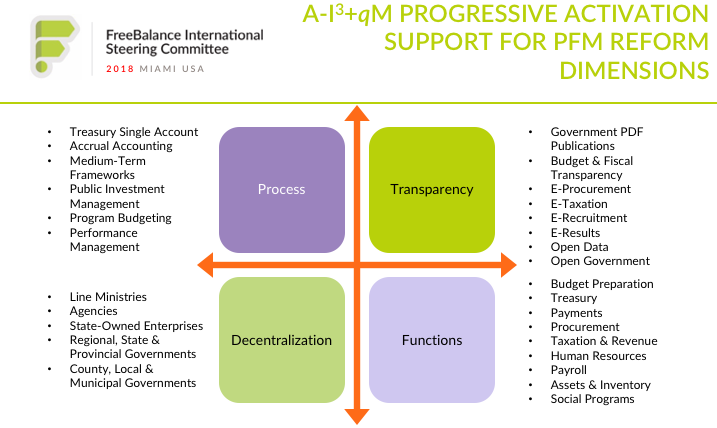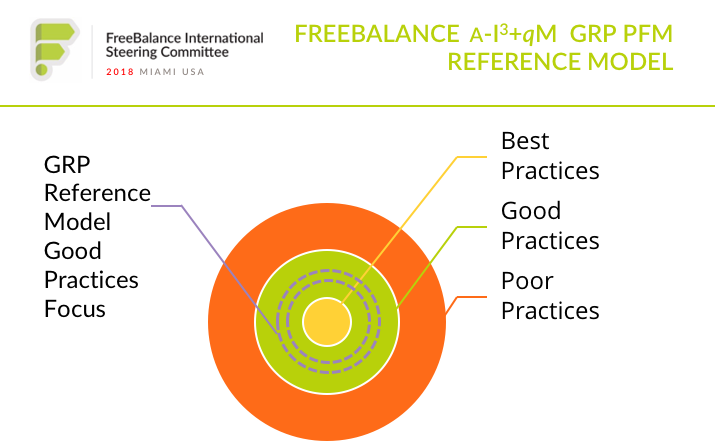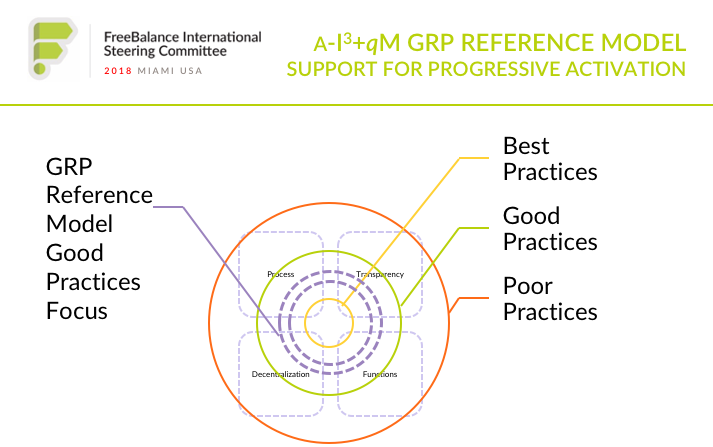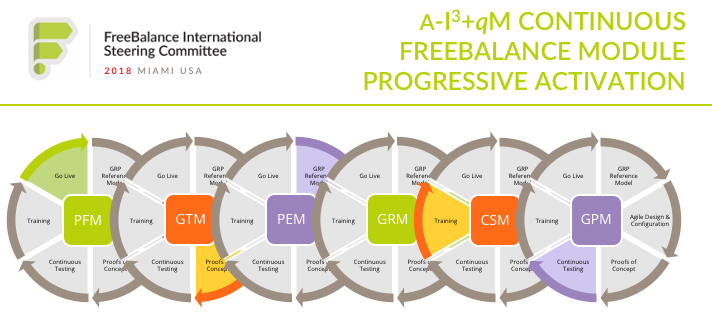 FreeBalance customers are accustomed to change. That’s the nature of government. Political changes. Reform. Process changes. Reorganization.
FreeBalance customers are accustomed to change. That’s the nature of government. Political changes. Reform. Process changes. Reorganization.
Oddly, “best practices” remains a dominant meme among government technology providers and experts. Practices can hardly be objectively “best” when constantly in flux.
We’ve had many discussions with our government customers at FreeBalance International Steering Committee (FISC) conferences about change. And, the implications for core public finance systems. This was no different last month in Miami. FISC is highly interactive. It’s difficult for anyone to assert that any practice is “best” in any universal sense.
Government organizations are constantly in search of better practices: good practices appropriate to the context. Yet, many implementations of Government Resource Planning (GRP) are predicated on the notion of “best”. Implementations are designed with business process re-engineering to arrive at the “best practices” destination. Charts of Accounts redesign. Accrual accounting. Treasury Single Account (TSA). Legal reform.
The Implementation Reality
Implementations of government financial management systems rarely follow the “best practices” game plan. Legal reform takes time. Politics get in the way. New e-procurement or tax administration software cannot be implemented because the reform bill has yet to pass. And, the approved law doesn’t reflect envisioned practices in financial software.
Accrual accounting, and TSA are often multi-year initiatives. Radical changes to account structures generate confusion.
It’s high time to look at information system flexibility to support organic government process change. We need to ditch this IT ‘best practices’ foolishness in public financial management. ‘Best practices’ seems more vendor-speak, particularly ERP vendors. A euphemism for what vendors have built into software. And, very hard to change without code customization. What technology analyst, the Gartner Group, calls legacy ERP.
There is a better “postmodern” way. We call it “progressive activation”.
GRP Progressive Activation and Government Reform
Governments modernize public finance processes. Governments decentralize. Governments automate more public finance functions. Governments improve fiscal transparency.

Reform and modernization differs among governments based on context. Larger and more populous countries often decentralize. Resource-rich countries focus on tax reform. Liquidity problems often prompt treasury reform. Governments with infrastructure needs look to public procurement and contract management modernization.
GRP software must facilitate reform across all modernization dimensions. Inflexible technology gets in the way of government reform all to often. Highly flexible GRP enables modernization through configuration change, not code customization.
Agile Government Progressive Activation
FISC 2018 attendees learned about our agile methodology update, A-i3+qMTM. The methodology update formalizes progressive activation beginning with initial configurations through a “GRP Reference Model”.

The GRP reference model is a blueprint consisting of a range of typical governance good practices. The model becomes an anchor point to compare current and aspired-to practices. The GRP Reference Model enables FreeBalance consultants to explore good governance practices when designing configurations blueprints.
This blueprint approach is designed to eliminate many of the deficiencies of traditional government IT project management. FISC 2018 attendees spoke about how rigid processes inflict project delays and increase risk.
The FreeBalance implementation team does not request government personnel to articulate detailed workflows and business rules when using A-i3+qMTM. We ask how government organizations follow public finance practices like committing and obligating funds. Our team works with government organizations to determine how public finance practices can change to meet objectives.
The GRP Reference Model configuration supports most government “to-be” public finance practice aspirations.
Blueprints are developed from the GRP Reference Model. These blueprints are used to configure the FreeBalance Accountability Suite as Proof Of Concept (POC) candidates that are tested in production, and can be adapted in production to meet needs.
That’s an advantage of massively configurable systems that support progressive activation: POCs move into production. The Chart of Accounts (COA) doesn’t have to be perfect. FreeBalance supports a multiple year COA. Governments can migrate to accrual accounting and TSA.

The GRP Reference Model simplifies progressive activation through targeting the four dimension of PFM reform and modernization. Governments are able to select from a menu of process, functions, transparency and decentralization good practices to create PFM reform roadmaps.
Functional Progressive Activation
Most FISC 2018 attendees came from governments that have experienced multiple reform phases. We had one attendee from the very first FISC in 2007 whose country had basic financial functionality at the time. That country is now running advanced functionality for budget formulation, budget execution, procurement, contract management, payroll, human resources, performance management and transparency.
Many commercial applications, like most ERP, provide some element of integration among modules. These vendors talk about integration, even though there are numerous constraints. Acquired software companies with different technology underpinnings mean that traditional metadata management and enterprise integration tools are needed. In other words, the very same tools required to integrate systems from different vendors. And, the leading legacy providers developed software in monoliths meaning that metadata management is required to integrate modules developed with the same platform.
This is an untenable form of intra-suite integration.
The FreeBalance Accountability Suite was developed with a unified design. This means that configuration and metadata developed with any module is reused for new modules. The COA created in one module is reused across the Suite to enable functional progressive activation.
And, FISC attendees are aware that existing functionality can be leveraged for product roadmap items. This helps in identifying priority roadmap items. FISC attendees adjust our product and services roadmap every year.

Functional progressive activation operates at all implementation phases:
- Phased Approach: modules are implemented in phases based on government priorities, to deliver needed functionality quickly
- Workshops: Demonstrations and design thinking sessions provide visualization that accelerates needs analysis and align software to real requirements
- Storyboards and Blueprints: Visual tools accelerate the process of articulating configuration and customization needs that generate test plans rapidly
- System Configuration: Rapid configuration, without the need for software coding, validates whether changes meet requirements.
- Small Tests and Quick Wins: Modules can be tested quickly in production proofs-of-concept to demonstrate progress, identify quality issues and reduce change resistance
Understanding “Why” – The Customer Innovation Value of FISC
The FreeBalance management team was a bit skeptical when our President and CEO, Manuel Pietra, explained the premise of FISC in 2006. This was not how enterprise software firms behaved. The results have exceeded expectations. FISC has provided FreeBalance decision-makers with context. We understand why our government customers have requested specific features or services. We’ve learned about motivations for change. Of daily challenges. Of reform incentives.
We’ve also learned how passionate public servants uncover good governance opportunities. I believe that the full time interaction between FISC attendees and FreeBalance executives improves our decisions. That’s customer innovation.
